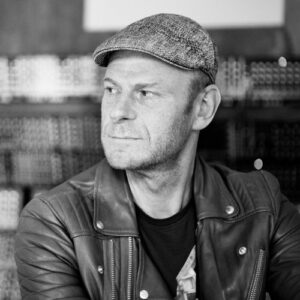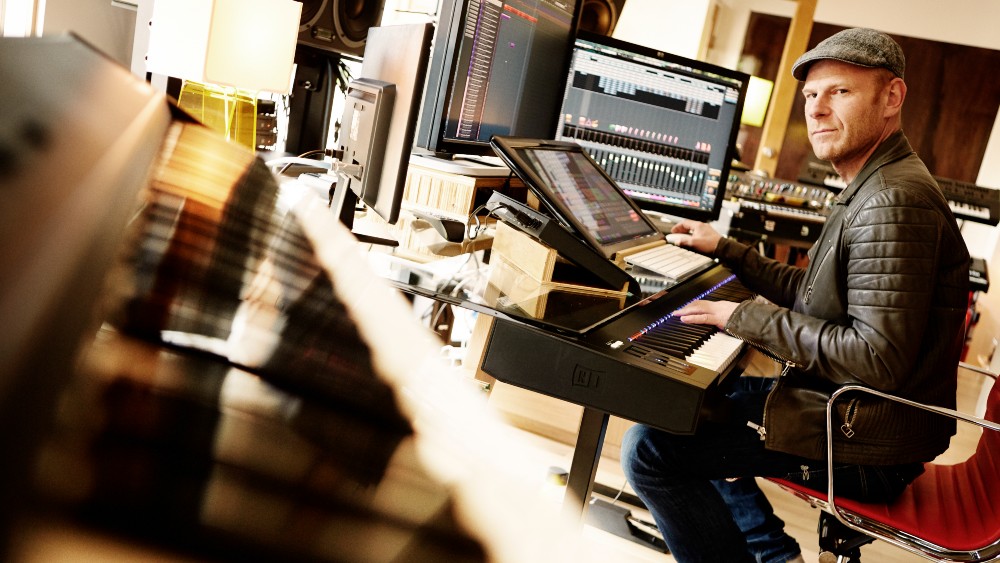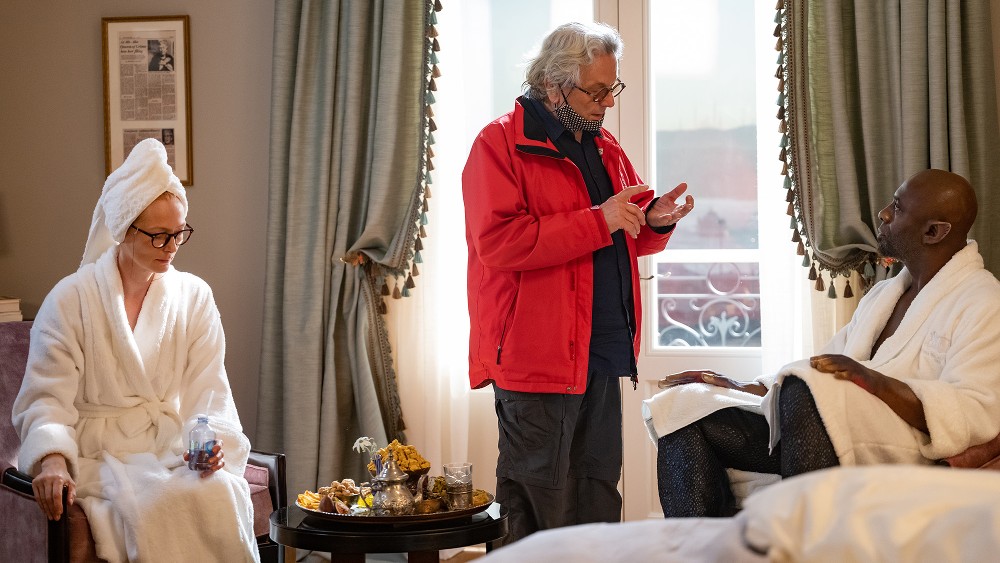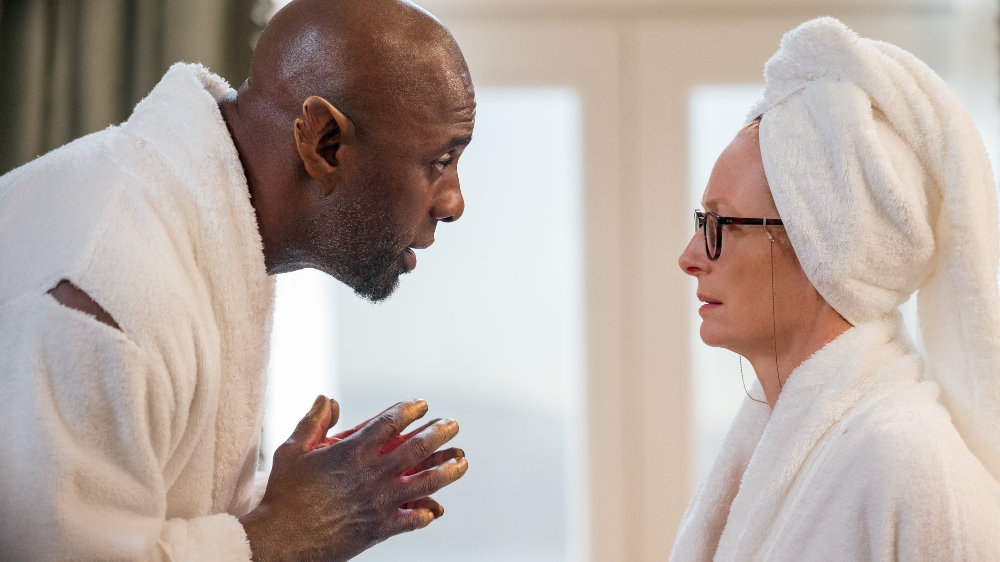George Miller’s adaptation of Three Thousand Years of Longing flew under the radar when MGM released the film earlier this year, but it’s worth seeking out on VOD and digital platforms, as not only is it a visual feast, but it once again finds Miller working with Grammy-nominated composer Tom Holkenborg (aka “Junkie XL”), with whom he worked on Max Max: Fury Road. Holkenborg gives Miller’s latest film a rich score that’s beautiful to listen to both in the picture, and on its own.
The movie stars Idris Elba as a Djinn who has been trapped in a bottle for thousands of years before being released by Tilda Swinton‘s historian, Alithea, who finds his bottle in a thrift store in Istanbul. Over the course of the movie, the Djinn relays to Alithea the stories from his past and how he ended up in that bottle.
Below the Line spoke with Holkenborg last year for Godzilla vs. Kong and Zack Snyder’s Justice League, but we followed up with him a few months ago to discuss his second collaboration with Miller. Eventually, we got into his love for the Tom and Jerry cartoons that influenced his work on the scores for Sonic the Hedgehog and its sequel earlier this year.

Below the Line: Obviously, you have a great relationship with George from your collaboration together on Max Max: Fury Road, and I see you have a poster for that film right behind you.
Tom Holkenborg: This is the only poster that I have hanging in my living room because having finished Mad Max, I did Divergent before that and 300: Rise of an Empire. Once I finished Mad Max, that was the first time I was taken seriously as a potential new composer on the block in Hollywood, because if you survive the process with George Miller, obviously, you’re able to do something [well].
BTL: With that in mind, when did he come to you with Three Thousand Years of Longing, and did you already know he wanted to explore a different world before returning to the desert for the Fury Road prequel Furiosa?
Holkenborg: I knew that already. George and I, when we worked on Fury Road, not only did we create a really great working relationship, we also became really good friends. We stayed in touch on a bi-monthly [or] tri-monthly basis, and we would have a two or three-hour talk about random things in life, but also both our careers. [Fury Road] came out halfway through 2015, and in 2016, we already started talking about Three Thousand Years of Longing. Then I got the script somewhere halfway through ’19. He started shooting in February 2020, and the main theme and a few arrangements of the base theme were all created [between] November 2019 and November 2020.
BTL: Did you read the short story as well, or did you just go by his adapted script?
Holkenborg: I got the whole script, and then we talked about what this theme needed to do. It was basically one melody that would be able to carry the whole score, and then I finished three specific themes, and George actually shot those scenes to the music.
BTL: Do you remember which scenes those were?
Holkenborg: The most important one is the one [when] Solomon (Nicolas Mouawad) comes to Sheba (Aamito Lagum), and he brings this incredible instrument. That scene was completely recorded, like, in detail, to the music that I wrote. I have this notebook here, and I was making some notes for myself, but somewhere in here it [says] exactly how that scene needed to go, what needed to go first, what needed to go second. [Starts leafing through a notebook looking for something to show us.]
BTL: Do you keep a notebook for every project you work on, or just specifically for this movie?
Holkenborg: I have one specific notebook for each film or for a specific time period. So this one is for Three Thousand Years of Longing and for the finishing of Justice League, the Snyder Cut. At a certain point, we were talking about the scene with Solomon, and [George] had an idea [of] how he wanted to shoot this scene. The whole idea was that I would follow his description of the scene in detail [to the second]. That would eventually create the scene that I’m talking about.
[Gets to the page in the notebook he was looking for]
This is the description of what that scene is, and then I took the theme, and I arranged it completely like that. It’s like [reading] “at zero seconds, no music; at four seconds, a quick flourish like flamenco, really loud; three to four seconds and a quick stop; at seven seconds, start takes this; at nine seconds start this.” So [it’s a] complete shot list of what he needed, and I needed to take the theme and squeeze [it] into this whole book of individual notes. We did a few scenes like that, and it was really interesting to approach it like that. I’ve never done that before, on that level.

BTL: And he hadn’t actually shot the movie yet when you got that?
Holkenborg: This was prior to shooting. They were rehearsing, potentially, what the scene could be already based on a piece of music I delivered, and then he gave very specific notes from zero to three seconds, from three to seven seconds, and all the way [to] the end — one minute five, one minute ten, however long that scene is. They played it on set, and I did the same thing with two other scenes.
BTL: I noticed that you have longer cues on the soundtrack album, such as “The Two Brothers” and “As a Consequence of Zefir,” so were those pieces that were broken up into different parts of the movie?
Holkenborg: They’re both one scene, but there’s so much subtle sound design in the film as well, and there are these moments where the theme actually plays on five or six occasions. I just wanted to add something to the soundtrack that comes from the film, but it’s not so thematic in nature. It’s more sound design in nature with some percussion that comes in and goes out. I thought it would have been a nice addition to it. Actually, these are very important scenes in the movie. “The Two Brothers” is the first part of the Ottoman Empire, one is locked up in this room with the bigger ladies. It’s that story, and “Consequence of Zefir” is the love relationship 200 years later that the Djinn is developing with this woman who wants to have all the knowledge of what the Djinn has, and then eventually, she goes completely crazy because it’s too much for her to handle. When they get into a fight, she screams, “I wish you were in the bottle on the bottom of the sea,” and that was her third wish, so poof… he was back in the bottle until Alithea bought it in the store.
BTL: Obviously, there’s an Arabian Nights quality to the flashbacks. Did you have to do any research or study different tunings or instrumentation for those scenes, or did you already have those things in your wheelhouse from other projects that you’ve done?
Holkenborg: The difficult thing was, as I said earlier, that one melody was able to carry the whole film, and it needed to feel timeless. I knew this melody for so long, but you can’t remember where you heard it before. At the same time, it can live for a long time, so the melody really found its roots in the music from the 17th and 18th centuries, but the way that it is performed by Max [Karmazyn] on the viola — who is actually Moroccan-Jewish, but he lives in Los Angeles — is incredible, because he is a star violin player, but he knows how to give it this Yiddish touch, which fits with Solomon.
And then, he knows how to give it that Arabian classic touch that fits in with the Ottoman Empire, one of the oldest civilizations in the world, to give it that old music quality. In the first scene with Solomon, there’s a lot of instrumentation there that is really old, like certain percussion instruments, finger snaps, and things like that. They’re pretty old instruments. And then, it goes all the way up to the end of the movie, where it’s a modern string arrangement. [That’s] how the movie ends.
And then after that, we have the same theme, but now it’s sung by Matteo Bocelli. There, we did something similar, where the oldest lyrics being used are something that would have been potentially Aramaic, which is the oldest language. George worked with a scholar, who taught Matteo what that language potentially was, and then we move through various different languages until we finally end up in English.

BTL: I know you play a lot of instruments yourself. For this one, did you end up bringing in other musicians and working with other musicians more than on some of your other scores?
Holkenborg: I play the fiddle a little bit, but not like Max [laughs]. We worked with a really good harp player, who was able to play all the complex things that I wrote for Solomon to play. There’s a whole sound design department that goes with that, which I spent so much time on, because it’s a fancy instrument that he plays on, it’s not a real existing instrument. The end results needed to have that same feeling, just like, “Oh, I know what this instrument is, but wait a minute, that’s not the instrument that I know.” It’s kind of the same thing.
I worked with a really technical percussion player, who helped me master those really typical things from old music percussion, but I played those instruments myself as well. So there are a few layers that are mine. I played some bass guitar with it as well, and some other weird sounds from acoustic machines that I have. Most of my stamp on this is how to make it sound, like, eventually, with layers of sound design with it. We constantly create this atmospheric sense that is about a timespan of 3000 years and not just like, “Oh, this is a piece of music here and now with four musicians in a room and that’s the Polaroid that we take.”
BTL: You mention that you use the same theme throughout the score. Though it can be irritating to hear the same theme repeated in a score, it never felt like it was overused in this film.
Holkenborg: Because it only plays six times, so the moments are really pinpointed where it plays. It plays after 20 minutes, then after 40 minutes, then 1:05, and then 1:15, and then there are a few iterations in a row [near] the end of the movie to hammer it home. That avoids [it feeling] like theme fatigue, but if you have a wall-to-wall score, you cannot do it with one theme — you need more. Especially if it’s wall-to-wall, you still have maybe six or eight moments, really, in the film, to hammer home a specific theme. If you compare it to Justice League, the Zack Snyder cut, even though it’s four-and-a-half hours long, even there [I] had to really pick what moment I’m gonna choose to really play the theme, and other moments are more, like, generic action music or generic underscore music, because there’s so much dialogue, and there are so many action sequences. You really have to look for, “Okay, this is a moment where you can hammer home your theme.”
BTL: The last time we spoke, movie theaters were just reopening and a year-and-a-half later. Were you able to work in the room with George spotting the cues in person with the Editor and Mixer?
Holkenborg: No, it was all done online. The majority of the work was done in 2020 and halfway through ’21, and Australia was really strict on COVID rules. You cannot just book a ticket to Australia; you have to jump through a bunch of hoops to get there.
BTL: Did George shoot the whole thing in Australia?
Holkenborg: As far as I know, yes. He did do a lot of location shooting in Istanbul. I think the majority of that might potentially already have been shot before COVID really hit, or just, like, right around the beginning. Or maybe just in the summer when COVID was pretty much non-existent in Europe. That’s when everything was on the rise in the United States. I have lots of friends in the Netherlands, and in 2020 they had a really relaxing summer. COVID was pretty much non-existent there, and then they had a huge spike at the end of the year.

BTL: Earlier, you mentioned working with Matteo Bocelli, so how did that collaboration come about? Was that one of George’s ideas early on, or something you pitched to him?
Holkenborg: He had an idea to work with Matteo on a song, and then I suggested to George to look at how they did it with Titanic, where the theme is, like, throughout the movie, and then when we get to the main titles, Celine Dion was actually singing the theme as it appears in the film. He really liked that idea, and then I started working on arrangements. I met with Matteo — a really wonderful person — and he also plays in the movie as an actor. It all made sense to do it like this, so how that’s how we did it. He actually sings the melody as it appears in the movie.
BTL: Since things have improved a bit since last we spoke, are you getting back to work in the ways you were able to work pre-COVID?
Holkenborg: My way of working is actually pretty much the same as [during] COVID, mostly because most of the people [who] work with me really love working from home, and they can decide when they can work [and] when they’re not working, as long as they get things done before a certain date. Obviously, we all missed the social elements of being in one studio with each other. But we fixed that by just organizing big dinners every two weeks, and then we don’t have to deal with work, and we can just drink beers and barbecue, so that’s how we solved that. But when it comes to the work work, everybody really loves working from home.
BTL: I’m not sure I knew that you scored the Sonic the Hedgehog movies, including one since we last spoke. It’s not like you had to change your style of music too much, but it was interesting to see how your music was used in those movies.
Holkenborg: Normally, I wouldn’t necessarily get approached to do a movie like that, but the interesting thing is that I also did the first Sonic the Hedgehog. The director for this movie used to be the main assistant to Tim Miller, for whom I did Deadpool with. He really wanted to work with me, so we found a way to give it the music that [he] likes. I’m an incredible Tom and Jerry fan, and I have all the cartoons from the golden period. Between the way that it looks, but also the music — and that’s the Fred Quimby–Scott Bradley time period — it’s like the early ’50s into the mid-’50s. And then, in the ’60s, Tom and Jerry started to change when Chuck Jones came in, and it became more like Tom and Jerry in Space, and Tom and Jerry here, and Tom and Jerry in the times of the pharaohs in Egypt. It became more like that. I’m talking about that time period [when] it was like the classic American household with the big pit bull in the yard, that time period. Obviously, nowadays, a lot of these cartoons will not pass the smell test of racism and everything that comes with it. [But] the quality of the music is sensational, and there’s this incredible performance by the London Philharmonic, where they play Tom and Jerry’s Greatest Hits, and these are all the pieces that Fred Quimby and Scott Bradley created together.
When I started talking to [Director] Jeff [Fowler] about Sonic the Hedgehog, it was really like, “Tom and Jerry, what would they have done?” It’s really fast music. It’s jolly, it’s uplifting, and then something dark for Jim Carrey, but dark that puts a smile on your face instead of dark like, “Ooh, it’s dark.” Like, for instance, the Imperial March of the first Star Wars movie. Yeah, it’s dark music, but it puts a smile on my face. It’s not dark like 300: Rise of an Empire or Batman vs. Superman dark.
BTL: Do you have Tom and Jerry cartoons from those times on film?
Holkenborg: I have everything digitized. In the ’80s and ’90s, at a certain point, Warner Bros. was releasing the Best of Tom and Jerry on Triple VHS boxes, and later, like I said, DVDs. You had to buy those compilations every time because there were, like, four episodes that you didn’t have before. In total, I have maybe 120 or 140 episodes or something like that. The other one that I was a massive fan of that I collected as well was Roadrunner and Coyote.
BTL: Warners is making a movie based on those characters [Coyote vs. ACME], so is that something you might throw your hat into the ring to score?
Holkenborg: Honestly, I didn’t even know they were doing a movie.
Three Thousand Years of Longing is available to buy or rent on all major digital and VOD platforms. The original motion picture soundtrack is available through Milan Records and on all music streaming platforms.





